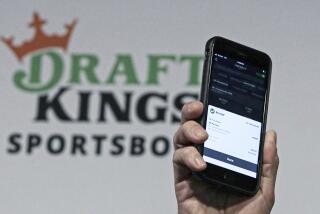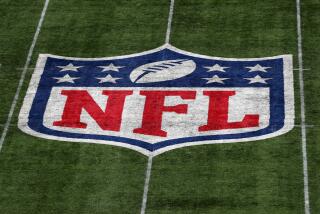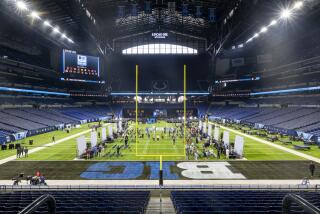ANALYSIS : Will NFL Have to Go to Plan C? : Antitrust: Jury in Minneapolis finds the league operating illegally. It could cost owners hundreds of millions more in the long run.
- Share via
MINNEAPOLIS — It wasn’t a knockout. As the players said afterward, the NFL owners are too powerful and influential to knock out.
But in a landmark antitrust trial that ended here Thursday, the NFL’s players won again.
In the last two years, they are 15-0 against the league’s 28 club owners, who were again found guilty of assorted antitrust violations--a set of infringements that will cost them $1,329,000 in trebled antitrust damages, and possibly $200 million more.
The extra millions represent the damages that the NFL Players Assn. expects to win when the suits of more than 1,000 other athletes come to trial later this year on the same grounds.
But damages are always hard to predict in NFL antitrust cases. Joe Kapp once won a case against the league but was awarded no money.
This time it was former UCLA running back Freeman McNeil and three additional NFL pros who successfully sued but won no money.
In Judge David S. Doty’s district court, a jury of eight Minnesota women awarded the four others somewhat modest amounts--$240,000 to Dave Richards, $178,000 to Mark Collins, $50,000 to Frank Minnifield, and $75,000 to the retired Lee Rouson.
But as NFLPA spokesmen said afterward, it wasn’t the money, it was the principle.
The principle is NFL illegality.
The jurors, when asked if league rules are substantially harmful, replied unanimously in the affirmative.
“We didn’t have any trouble deciding the (issues),” juror Helen Shriner said afterward. “We were all in agreement on (those). All eight players were harmed--the evidence showed that. But we didn’t find enough evidence to award damages to (McNeil, Don Majkowski, Tim McDonald and Niko Noga).”
The jurors came to the trial from eight different vocations.
Shriner, 45, a cashier at a grocery store in neighboring Worthington, Minn., said the jurors’ hardest job was assessing exact damages.
“The testimony wasn’t (precise) enough on that point,” she said. “We agreed on the (issues) on the (first ballot), but we disagreed time after time on the damages.
“Someone would mention a figure and ask, ‘What do you think of that?’ Then someone else would mention a figure. There was so much testimony from both the (players and owners) in this trial that we were just overwhelmed, but we did the best we could.”
Doty complimented the jurors on the final day for “a job well done.”
Shriner was asked if the jury favored some restrictions on player movement or total free agency.
“We thought there should be some restrictions, but this plan is much too restrictive,” she said.
The players, who also favor some restrictions, have been seeking free agency for veterans of four years in NFL football.
“That sounds reasonable to me,” NFLPA Executive Director Gene Upshaw said. “We have never asked for total free agency.”
The trouble with a trial like this, Shriner said, is there is almost too much testimony.
All told, the players sent up 22 witnesses and the owners 10. There were 1,700 pieces of evidence. The judge’s instructions, which required more than an hour, ran to 46 pages.
Critics said that the league harmed itself, however, when none of its 28 club owners took the stand. Raider owner Al Davis and others had been scheduled to testify, but in the end they didn’t.
The list of owners willing to testify originally had been prepared before trial testimony disclosed their salaries and profits. These figures ranged upward to the $7.5 million Norman Braman paid himself in 1990 as the owner of the Philadelphia Eagles.
Jim Quinn, the players’ lead attorney, speculated that the owners were all removed from the witness list when their lawyers advised them that because of earlier testimony, they would be required to answer questions about their profit structures.
A central argument in the players’ case is that owners’ profits have been unduly high because the league’s Plan B restrictions enabled them to pay their players under market value.
Dollars and cents were also central to the owners’ case. They said their players are already well enough paid.
In his closing argument, for example, NFL lead attorney Frank Rothman pointed to the players’ salaries and said: “What in the world are (they) complaining about? . . . They’re greedy.”
Said player attorney Quinn: “Speaking of (greed), who set up the system to hold down salaries and keep up profits? It wasn’t the players.”
At the end of the trial, Doty said the jurors’ names and addresses would be released next Tuesday, when, if they chose, they would be available for media interviews.
Then he asked the jury to file out of the courtroom “as usual” before anyone else departed. And as they left, he asked a courtroom attendant to close the door and keep it closed “until the jurors pick up their personal effects” and left the courthouse.
The Marcus Allen case in Los Angeles is the next one that the players have scheduled for trial. The Raider running back has sued the club and the league on the same grounds that were decided against the league Thursday.
“The (facts) were established in the trial here,” NFLPA attorney Dick Berthelsen said. “The only thing left to decide in the Marcus Allen (trial)--and in the other trials involving more than 1,000 of our players--is the damages.”
A Raider attorney had no comment.
And so the longest running story in pro football--the players’ long fight against the owners--goes on.
The owners had made their Plan B arrangement in the first place--made it unilaterally--because of a player victory in an antitrust case.
Since mid-century, the players have been winning repeatedly in court, every few years, and then losing to owner policy adaptations. The owners each time conform narrowly to the newest court decision, and then wait for the players to sue.
It drains the NFL of millions, but there are 28 multimillionaires and billionaires to share the costs. They don’t seem to mind.
Thus, in the present argument over next spring’s college-player draft, NFL Commissioner Paul Tagliabue is probably right and NFLPA executive director Gene Upshaw is probably wrong.
Tagliabue keeps saying: “We’ll have a 1992 draft as usual.”
Upshaw said Thursday: “They’ve had their last draft.”
Don’t bet on Upshaw.
Even though the owners have lost 15 lawsuits to the players in just the last two years, and won none, they always find another way to do what they want to do.
The Verdict
A jury of eight women, after deliberating for two days on a case that started June 15 and lasted 36 days, found the NFL liable in all eight players’ cases with four awarded monetary compensation.
Total damages amount to $543,000 (trebled under federal antitrust laws to $1.63 million).
The players who were awarded damages:
* David Richards, San Diego Chargers: $240,000.
* Mark Collins, New York Giants: $178,000.
* Lee Rouson (retired), Cleveland Browns: $75,000.
* Frank Minnifield, Cleveland Browns: $50,000.
More to Read
Go beyond the scoreboard
Get the latest on L.A.'s teams in the daily Sports Report newsletter.
You may occasionally receive promotional content from the Los Angeles Times.










